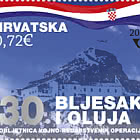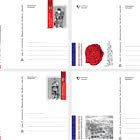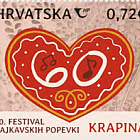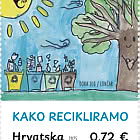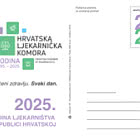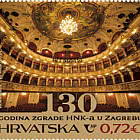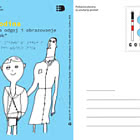Croatian Fine Arts
Vanja (Ivan) Radauš (Vinkovci, 29 April 1906 – Zagreb, 24 April 1975)
Artist – sculptor, painter, printmaker, medalist, professor at the Academy of Fine Arts in Zagreb and academician, poet and photographer, a passionate and emotional individual, he is a famous Croatian who created works in all sculptural branches, from medals, sculptures in terracotta, plaster, stone, wax and bronze to important public monuments, and he is justifiably considered one of the most important and greatest Croatian sculptors of the 20th century.
His sensibility towards the environment, reality, society and life was directly manifested in the production of his artistic creations in terms of stylistic versions, making him permanently unconventional both as an artist and as an individual.
Just as it will remain a permanent challenge for the interpretation of Radauš’s artistic oeuvre, the circumstances of his death also remain unclear. But it is also an additional aura of intrigue that surrounds Vanja Radauš.
The entire Croatian art criticism considers him a visionary inclined to experiment outside conventional patterns, escaping generational and stylistic categorizations and groupings. Despite this, but also because of it, he is rightly considered part of the Croatian sculptural “triumvirate”, together with Augustinčić and Kršinić, who bequeathed to Croatian modern art history some of the most interpretatively challenging sculptural achievements.
At the art academy in Zagreb, he was taught by R. Valdec and R. Frangeš Mihanović, and from 1928 he was in the class of I. Meštrović. He became a professor in 1945 at the Academy of Fine Arts, where he worked until his death. From 1947, he was a regular member of JAZU, he led the Masters workshop for sculpture in Zmajevac, and in 1950 he represented Yugoslavia at the 20th Biennale in Venice – together with Augustinčić and Kršinić.
In 1932, for one year, he was a member of the Zemlja group, whose programmatic positions on social sensitivity remained his permanent artistic preoccupation.
From 1939, when, at the age of 33, Radauš, together with Jozo Turkalj, created his first large public monument, the Monument to Fallen Warriors in the First World War, erected on Mirogoj, he regularly made monuments for public spaces, from busts to monumental figures and compositions. After the Second World War, after a series of academic solutions for monumental compositions, the affirmation of his sculptural expression began.
Among the best, and according to critics, the most significant works of Radauš’s oeuvre are his sculptural cycles: Typhoid Sufferers (1959), Man and Karst (1961-64), Portrait of our Man (1970s) as well as medal works and graphic maps: Dance macabre (1093-39), We Remember (1945). It is also worth mentioning the cycles Bloody Masquerade (1966), Abstract Forms (1966-68), Prisons and Camps (1969) and Slavonia (1970s), where he devoted himself to his native region with which he shared a permanent emotional connection.
The above-mentioned and specially singled out contribution to the history of Croatian sculpture is Radauš’s sculptural cycle Panopticum Croaticum, created in the period from 1959 to 1961. Over two years, the cycle included 25 sculptures. It consists of two parts, a group of figures called The Trial and a depiction of the greats of Croatian culture: V. Lisinski, A. Jamometić, V. Karas, J. Račić, Matoš, I. Kozarac, I.G. Kovačić, F. Galović, A. Cesarec, F. Supilo, J. Polić Kamov, F. Krežma, E. Kvaternik, J. Križanić, S.S. Kranjčević and Slava Raškaj. With this extremely expressively cycle, almost in the form of Art Informel, Radauš showed the drama of the tragic destinies of individual personalities, basing the shaping of the figure on a specific tragedy that determined the representation and attributes, at the same time carrying a portrait characterization.
With this approach to shaping the sculpture, Radauš achieved a strong and lasting effect on both the audience and critics. It is considered that one of the most impressive sculptures of that cycle, and of Radauš’s entire oeuvre, is the sculpture depicting Slava Raškaj. The Croatian painter, who spent her life as a deaf and mute artist, spent the end of her life in the Institute for the Mentally Ill in Stenjevac, with a darkened mind, believing that she was a bird. Symbolically using that tragic fate, Radauš made Slava Raškaj as a bird – truncated and ghostly, with heavy legs and clipped wings.
Frano Kršinić (Lumbarda, 24 August 1897–Zagreb, 1 January 1982)
Frano Kršinić was a sincere and true devotee and lover of the stonemasonry skills of his ancestors, and he received his first lessons in stonemasonry in his family in his native Lumbarda. He carried the feeling for stone and his native land in his heart to the end of his life and wove it into his sculptures, both in themes and design. For him, the stone was an inspiration, a driver, a necessity and respect that was translated into some of the most tender compositions of female characters – intimate, lyrical and quietly powerful. He liked to carve his own sculptures. As a respected pedagogue, he supported freedom of experimentation in sculpture, but until the end of his life he remained an advocate of figuration, because he said that he can only do what he experiences, lives and feels.
He received his education as a stonemason and sculptor at the stonemasonry department of the craft school in Korčula, at the sculpture and stonemasonry school in Hořice in the Czech Republic (teacher Q. Kocian) and at the Academy of Arts in Prague (professors J.V. Myslbek and J. Štursa). He worked in Prague until early 1921, then he moved to Zagreb, followed by Zemun in 1922. At the invitation of Ivan Meštrović, he came to the Royal Academy of Arts in 1924 to be a teacher.
He made a study trip to Greece in 1922, France and Germany in 1937, and the Netherlands, Belgium and France in 1958. He was a co-founder of the Zemlja group in 1929, but resigned the following year.
He was a professor at the Academy of Fine Arts in Zagreb from 1940 and rector from 1943.
From 1947, he was the head of the Master’s Workshop, a postgraduate study outside the Academy of Fine Arts in separate buildings. From 1948, he was a member of the Yugoslav Academy of Arts and Sciences. During his lifetime, he had ten solo exhibitions, and exhibited at 145 group (collective) exhibitions. He exhibited at the Biennale in Venice in 1940 and 1950.
An important part of Kršinić’s life was his pedagogical work. He was a teacher of the sculptors who marked the Croatian sculpture of the second half of the 20th century: Vanja Radauš, Ivo Lozica, Vojin Bakić, Dušan Džamonja, Branko Ružić, Kosta Angeli Radovani, Ksenija Kantoci, Ivan Kožarić and Šime Vulas.
It is considered that he, along with Ivan Meštrović and Antun Augustinčić, contributed to the development of modern Croatian sculpture. Having built his own expression under the influence of Bourdelle, Despiau and Meštrović, his sculpture represented a break with symbolism and ornamentation in sculpture for Croatian sculpture.
Kršinić’s creativity (over 500 works) in the history of Croatian fine art is characterized primarily by depictions of female figures, created in traditional sculptural materials (bronze, stone and marble), and inspired by the cheerfulness and beauty of his native Mediterranean region. However, his sculptural creations of native, portrait, sacred and monumental themes are not to be neglected for Croatian heritage, among which there are also some public representative monuments of socialist realism stylistic expression.
His sculptures are kept today in numerous national museum institutions around the world. He organized numerous independent and participated in group exhibitions in the country and the world, and for his work and contribution to art, he was awarded with prominent awards – the State Award for Sculpture in 1949 (for the sculpture Pleti me pleti majčice), the City of Zagreb Award in 1956, the Order of Labor in 1957, the “Vladimir Nazor” Award for lifetime achievement in 1962, the AVNOJ award in 1968.
Stylistically consistent, independent of the spirit of the times in which he created, Kršinić is, in the words of Ivo Šimat Banov, a sculptor of “psychologically motivated realism.” With sculptures of women in all stages of life – from childhood to motherhood, Kršinić achieved the highest artistic reach. It is a stylistically recognizable expression that characterizes the simplicity of the design, the purity and conciseness of the form, and the calmness of the line that gives the impression of silence to his sculptures, encompassed from all sides by the smooth and tense body, at the same time giving the impression of tenderness and monumentality.
Sculpture, in his words, was a process, and it can be said that this female figure in his oeuvre is one and the same sculpture, developing with each new attempt and transforming into a new variant, richer in art and composition. With each new version, Kršinić remained consistent with the closed form, harmony and balance of shape.
Having created a unique lyrical world of female figures, they can be typologically grouped into six thematic cycles: girls, bathers, allegories and symbolic representations, meditations, spinners and knitters, and mother and child.
The motif of meditation is not rare in sculptural work, and Kršinić’s Meditations are close in motif to Maillol’s nude sculpture Méditerranée from 1905, which depicts a young girl in a sitting position, knees close to the body and head slightly supported. He executed a series of sculptures with the theme of meditation from 1929, when the first one was created, to 1970. Over four decades, using consistent style and form, Kršinić depicted female nudes with variations in body position, and he modeled them in several sizes and carved about twenty of them in stone.
These eponymous sculptures have in common that they are the result of thoughtful and dedicated sculptural maturation and dedication to the female body that has summed up vitality and primalness. They are intimate, calm, shaped by a continuous simple gentle line, in which the position of the head gently bending in contemplation reveals the stillness and silence of his dedication to the stone, the Mediterranean and life.
Rašeljka Bilić, MSc, Art Historian
Croatia - Recommended stamp issues
WOPA+ recommended stamp issues
| Avatar - Fire and Ash |
| Issued: 03.12.2025 |
| ›New Zealand |
| 50th Anniversary of the Founding of the 24th November Bar Scout |
| Issued: 24.11.2025 |
| ›Montenegro |
| Krisjanis Valdemars |
| Issued: 02.12.2025 |
| ›Latvia |
| Sign Language - Good |
| Issued: 02.12.2025 |
| ›Bosnia and Herzegovina - Republic of Srpska |
| In Memory of the Fallen and Murdered on October 7, 2023 |
| Issued: 08.10.2025 |
| ›Israel |
| Annual Collection Folder (New York) |
| Issued: 05.12.2025 |
| ›United Nations |
| Year Set |
| Issued: 24.11.2025 |
| ›Isle of Man |
| Shipping in the 17th and 18th Centuries - Peat Shipping |
| Issued: 05.12.2025 |
| ›Netherlands |









